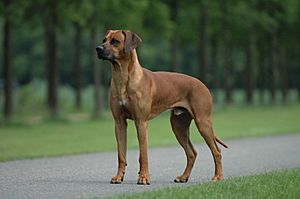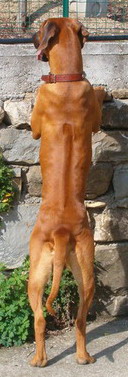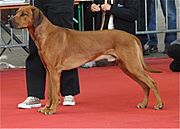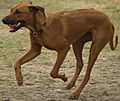Rhodesian Ridgeback facts for kids

Black nose Rhodesian Ridgeback
|
||||||||||||||||||||||||||
| Other names | African Lion Dog African Lion Hound |
|||||||||||||||||||||||||
|---|---|---|---|---|---|---|---|---|---|---|---|---|---|---|---|---|---|---|---|---|---|---|---|---|---|---|
| Origin | Rhodesia/Southern Rhodesia (Now Zimbabwe) | |||||||||||||||||||||||||
|
||||||||||||||||||||||||||
| Domestic dog (Canis lupus familiaris) | ||||||||||||||||||||||||||
The Rhodesian Ridgeback is a special type of dog known for its unique look and brave history. These dogs have a reddish-brown coat of fur. What makes them stand out is a line of hair along their back that grows in the opposite direction!
People sometimes call them The African Lion Dog. This is because hunters in Africa used them a long time ago. The dogs would help find and distract lions, giving the hunter a chance to shoot.
Contents
About the Rhodesian Ridgeback
What They Look Like
The most special thing about a Rhodesian Ridgeback is the ridge of hair on its back. This hair grows the opposite way from the rest of its coat. It starts behind their shoulders and goes down to their hips. The ridge usually has two swirly parts, called "crowns," at the top.
This unique ridge is thought to come from older African dogs that also had a similar ridge. An old painting in South Africa shows one of the first pictures of a ridgeback.
Male Rhodesian Ridgebacks are usually about 63 to 69 centimeters (25 to 27 inches) tall. They weigh around 36.5 kilograms (80 pounds). Female ridgebacks are a bit smaller, usually 61 to 66 centimeters (24 to 26 inches) tall and weighing about 32 kilograms (70 pounds). They are strong and muscular dogs.
Their coat should be short, thick, and shiny. It can be light wheat-colored to a reddish-wheat color. Small white patches are allowed on their chest and toes.
Ridgebacks can have a black nose or a brown (liver) nose. The color of their eyes should match their nose. Dogs with black noses usually have dark eyes. Dogs with brown noses usually have amber-colored eyes. Their tail is strong and smooth, often carried in a gentle curve.
Their Personality
Rhodesian Ridgebacks are known for being very loyal and smart dogs. They can be a bit reserved or shy around strangers. But this doesn't mean they are aggressive. A well-behaved Ridgeback won't attack someone without a good reason.
These dogs need consistent training and to meet many different people and places when they are young. Because they are strong-willed, they might not be the best choice for someone who has never owned a dog before. They are protective of their families. If trained well, they can make excellent guard dogs.
Even though Ridgebacks are strong and athletic, they also have a sensitive side. Early experts on the breed said that you should never treat these dogs roughly, especially when they are young. They respond best to fair and kind treatment from someone they know and trust.
Images for kids
See also
 In Spanish: Perro crestado rodesiano para niños
In Spanish: Perro crestado rodesiano para niños










